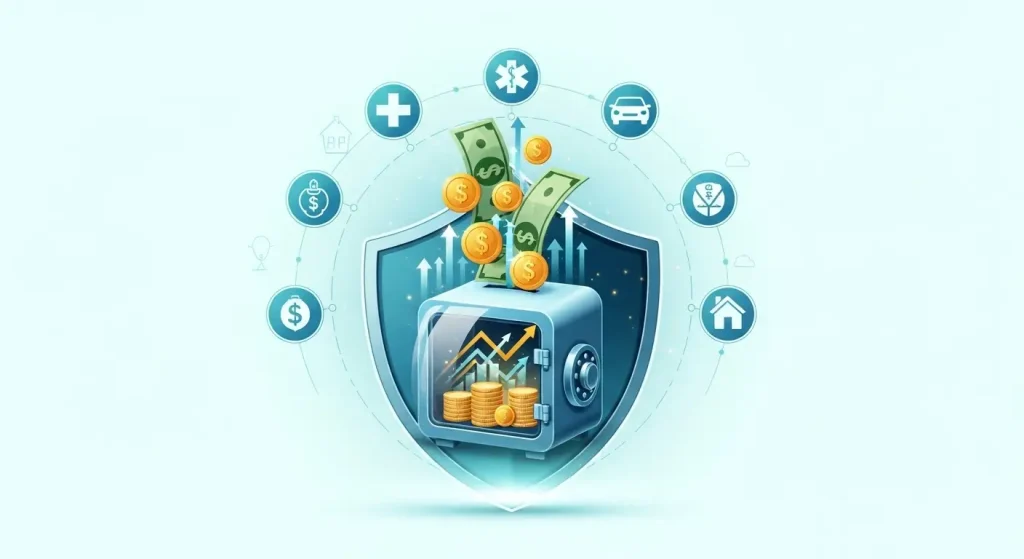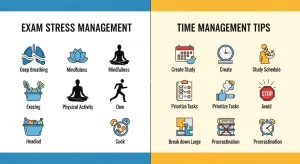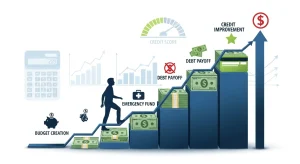Building an emergency fund is one of the most important financial steps you can take to protect yourself from life’s unexpected expenses. Whether it’s a medical emergency, job loss, or major car repair, having a financial safety net can mean the difference between weathering the storm and going into debt.
An emergency fund is an important step in protecting yourself financially from the unexpected – like a car repair, medical bill, or replacing an appliance – and staying on track to reaching your savings goals. The good news? You can build your emergency fund faster than you think with the right strategies and commitment.
Top 5 Budgeting Apps to Manage Your Money in 2026
Why You Need an Emergency Fund Right Now
Financial emergencies don’t wait for convenient timing. Recent studies show that 40% of Americans can’t cover a $400 emergency expense without borrowing money or selling something. This statistic highlights why building emergency savings should be your top financial priority.
Your emergency fund serves as a crucial buffer between you and financial disaster. Without one, unexpected expenses can quickly spiral into:
- High-interest credit card debt
- Payday loans with predatory rates
- Borrowing from retirement accounts
- Financial stress and anxiety
- Damaged credit scores
How Much Should Your Emergency Fund Be?
For a spending shock aim to save at least half of your monthly expenses. For an income shock aim to save three-six months’ worth of your expenses. Here’s a breakdown of emergency fund targets:
Starter Emergency Fund
- Goal: $1,000 – $2,500
- Purpose: Cover small emergencies while paying off debt
- Timeline: 1-3 months
Full Emergency Fund
- Goal: 3-6 months of expenses
- Purpose: Complete financial protection
- Timeline: 6-18 months
Extended Emergency Fund
- Goal: 6-12 months of expenses
- Purpose: Self-employed or unstable income protection
- Timeline: 12-24 months
Effective Study Techniques and Productivity Tips for Academic Success
8 Proven Strategies to Build Your Emergency Fund Fast
1. Automate Your Emergency Savings
One of the easiest ways to build your emergency fund is to automate your savings. Set up automatic transfers from your checking account to your savings account. Automation removes the temptation to spend money elsewhere and ensures consistent progress toward your emergency fund goal.
Action Steps:
- Set up automatic transfers on payday
- Start with $25-50 per week
- Gradually increase the amount as your budget allows
- Use a separate high-yield savings account
2. Use Your Tax Refund Strategically
If you’re looking for a way to quickly build your emergency fund, then using your tax refund to do so is a great option. When you file your taxes and ask for direct deposit for your refund, make sure you deposit the money directly into your savings or money market account.
The average tax refund in 2025 is approximately $3,000 – a substantial boost to any emergency fund. Instead of spending this windfall, direct it straight into your emergency savings account.
3. Generate Additional Income with Side Hustles
Taking on freelance work, selling unused items, or starting a side hustle are effective ways to boost savings. Even small additional income streams can help you build your emergency fund faster.
Quick Income Ideas:
- Freelance writing or graphic design
- Rideshare driving (Uber/Lyft)
- Food delivery services
- Selling items on Facebook Marketplace
- Pet sitting or dog walking
- Online tutoring or consulting
How to Build a Professional Portfolio: Complete Career Advice Guide
4. Cut Unnecessary Expenses Temporarily
Do you have multiple subscriptions to online services you rarely use? Temporarily reducing expenses can accelerate your emergency fund building without requiring additional income.
Fast Expense Cuts:
- Cancel unused subscriptions
- Cook meals at home instead of dining out
- Reduce entertainment spending
- Shop with grocery lists and coupons
- Use public transportation when possible
- Negotiate lower bills (phone, internet, insurance)
5. Choose the Right Emergency Fund Account
High-yield savings accounts and money market accounts are two common options. These accounts may earn more interest than standard savings accounts, helping your money grow while it sits idle.
Best Account Features:
- High interest rates (currently 4-5% APY)
- No monthly maintenance fees
- Easy access without penalties
- FDIC insurance protection
- Online and mobile banking access
6. Start Small and Build Momentum
Don’t let the size of your ultimate emergency fund goal overwhelm you. Starting small and setting up automatic transfers from your paycheck can help in building an emergency fund. Focus on reaching your first $100, then $500, then $1,000.
Milestone Approach:
- Week 1-4: Save $100
- Month 2-3: Reach $500
- Month 4-8: Build to $1,000
- Month 9-18: Complete 3-6 months expenses
How to Learn New Skills Online: Complete Guide to Online Learning Success
7. Use Cash Windfalls Strategically
Every unexpected money should go directly to your emergency fund until you reach your target:
- Work bonuses
- Gift money
- Insurance refunds
- Utility deposits returned
- Cashback rewards
- Garage sale proceeds
8. Track Progress and Stay Motivated
Visual progress tracking keeps you motivated during the emergency fund building process. Create a simple chart or use a savings app to monitor your growth toward your emergency savings goal.
Motivation Strategies:
- Set weekly mini-goals
- Celebrate milestones
- Share progress with an accountability partner
- Use a savings tracker app
- Post visual reminders of your “why”
Common Mental Health Issues & Self-Care: A Complete Guide to Better Wellbeing
Where to Keep Your Emergency Fund
Your emergency fund needs to be easily accessible but separate from your daily spending accounts. Consider these options:
High-Yield Savings Accounts
- Pros: Higher interest rates, FDIC insured, easy access
- Cons: May have transfer limits
- Best for: Most people building emergency funds
Money Market Accounts
- Pros: Competitive rates, check-writing ability, ATM access
- Cons: Higher minimum balances
- Best for: Larger emergency funds
Short-Term CDs
- Pros: Higher rates, guaranteed returns
- Cons: Limited liquidity, early withdrawal penalties
- Best for: Portion of a large emergency fund
Healthy Eating & Nutrition Basics: Your Complete Guide to Better Health
Common Emergency Fund Mistakes to Avoid
- Keeping funds in checking accounts – Low interest and easy to spend
- Investing emergency funds – Market risk defeats the purpose
- Using credit as emergency funds – Creates debt instead of security
- Not defining emergencies – Leads to inappropriate fund usage
- Stopping at partial funding – Incomplete protection is risky
Building Your Emergency Fund Action Plan
Phase 1: Foundation (Months 1-3)
- Open a high-yield savings account
- Set up automatic transfers
- Save your first $1,000
- Cut unnecessary expenses
Phase 2: Acceleration (Months 4-12)
- Increase income with side hustles
- Use windfalls strategically
- Build to 3 months of expenses
- Maintain consistent saving habits
Phase 3: Completion (Months 13-18)
- Reach your full emergency fund goal
- Fine-tune your savings rate
- Consider additional financial goals
- Maintain fund through regular contributions
Stress Management Techniques: 12 Proven Methods to Reduce Anxiety
Frequently Asked Questions
How fast can I build an emergency fund?
The speed of building your emergency fund depends on your income, expenses, and commitment level. With aggressive saving strategies like using tax refunds, side hustles, and expense cutting, you can build a starter emergency fund of $1,000 in 1-3 months. A full emergency fund typically takes 6-18 months to complete, but focused effort can reduce this timeline significantly.
Should I pay off debt or build an emergency fund first?
Financial experts recommend building a small starter emergency fund of $1,000-$2,500 before aggressively paying off high-interest debt. This prevents you from going further into debt when emergencies arise. Once you have this basic emergency savings cushion, focus on debt repayment while making smaller contributions to your emergency fund.
What counts as a true financial emergency?
A financial emergency is an unexpected expense that’s necessary, urgent, and you have no other way to pay for it. True emergencies include medical bills, essential car repairs, home repairs for safety issues, and job loss. Vacations, holiday gifts, and planned purchases don’t qualify as emergencies, even if they feel urgent.
Where should I keep my emergency fund for the best returns?
High-yield savings accounts currently offer the best combination of accessibility and returns for emergency funds, with rates around 4-5% APY. Money market accounts are another excellent option. Avoid investing your emergency fund in stocks or bonds, as market volatility could reduce your funds when you need them most. The priority is safety and accessibility, not maximum returns.
Retirement Planning Basics: Your Complete Guide to Financial Freedom
Take Action on Your Emergency Fund Today
Building an emergency fund quickly requires commitment, but the financial security it provides is invaluable. Start with small, consistent steps and use the strategies outlined above to accelerate your progress. Remember, every dollar saved brings you closer to complete financial peace of mind.
Your future self will thank you for taking this crucial step toward financial stability. The best time to start building your emergency fund was yesterday – the second-best time is right now.
Ready to supercharge your emergency fund building? Open a high-yield savings account today and start automating your savings:
Automatic Coin Sorting Piggy Bank :
Budget Planner & Financial Organizer :











